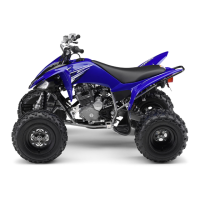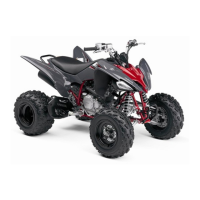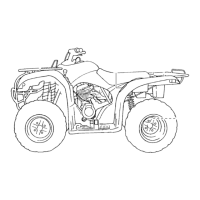Do you have a question about the Yamaha YFM250 and is the answer not in the manual?
Overview of the ATV, its features, and the importance of reading the manual.
Explanation of notations used in the manual for warnings, notices, and tips.
Specifies the ATV is for unpaved surfaces and advises checking local riding laws.
Guides users to find important labels on the ATV for safety and identification.
Covers age limits, operator restrictions, protective gear, and general riding precautions.
Advises on speed, terrain, body positioning, avoiding stunts, and required protective gear.
Guidance on riding on hills, water, and procedures for accidents or breakdowns.
Warns about potential hazards of aftermarket parts and modifications.
Illustrates and labels major parts of the ATV from left and right views.
Identifies clutch, brake levers, switches, and throttle on the handlebar.
Explains the main switch positions and the neutral indicator light.
Details light switch, engine stop switch, start switch, and throttle lever.
Explains the function and operation of the clutch, brake levers, and parking brake.
Describes the shift pedal for gear changes and how to open the fuel tank cap.
Crucial safety steps to prevent fires and explosions when refueling the ATV.
Explains the fuel cock positions (ON, OFF, RES) for fuel supply control.
Details how to use the starter (choke) for cold engine starts.
Instructions on how to access components by removing and reinstalling the seat.
Guides on adjusting front shock absorber spring preload for ride comfort.
Instructions for adjusting rear shock absorber spring preload for optimal performance.
Checklist for fuel, oil, brakes, fluid levels, and hydraulic systems.
Checklist for clutch, throttle, cables, drive chain, wheels, and tire condition.
Procedure for checking brake fluid level and overall brake system operation.
Step-by-step procedures for starting the ATV engine from cold or warm states.
Explains how to shift gears, accelerate, and decelerate properly for safe operation.
Recommended break-in period for the engine to ensure durability and performance.
Correct procedure for parking the ATV, including safety measures for slopes.
Advice on adding accessories and managing load capacity for safe operation.
General advice on understanding the ATV and fundamental safe riding practices.
Emphasizes the need for training, experience, and sensible operation.
Specifies age limits, passenger prohibition, and required protective gear.
Strong warnings against operating under influence and avoiding stunts.
Advice on how loads and accessories affect ATV handling and stability.
Reminders about body positioning, avoiding stunts, and consequences of improper operation.
Warnings about the hot exhaust system and potential fire hazards from debris.
Advises against paved surfaces and emphasizes checking local laws for unpaved roads.
Guidance on navigating rough terrain and avoiding obstacles safely.
Instructions regarding riding in restricted areas and on private property.
Explains how to properly turn the ATV, especially on unpaved surfaces.
Instructions for safely climbing hills, including weight transfer and terrain assessment.
Guidance on safely descending hills, including weight shift and braking.
Techniques for maintaining balance and control when riding across slopes.
Precautions for crossing shallow water and post-ride brake checks.
Techniques for managing skidding and sliding on slippery surfaces.
Solutions for common riding issues like turning, tipping, sliding, or failing to climb hills.
Emphasizes safety and performance benefits of proper vehicle upkeep.
Guidance on protecting and carrying the owner's manual and included tools.
Details maintenance intervals for emission control, general service, and lubrication.
How to check, clean, gap, and replace the spark plug for engine health.
Procedures for checking engine oil level, changing oil, and replacing the oil filter.
Steps to clean or replace the air filter element for optimal engine performance.
How to clean the spark arrester to prevent exhaust system issues.
Overview of carburetor adjustment and how to adjust engine idling speed.
Steps to check and adjust the throttle lever's free play for proper operation.
Warning about improper brake servicing leading to reduced performance and accidents.
How to inspect front and rear brake pads for wear using the indicator groove.
Procedure for checking brake fluid level and replenishing if necessary.
How to check for and address free play in the front brake lever and pedal height.
Steps to adjust the parking brake free play to ensure proper function.
How to check and adjust the clutch lever free play for smooth engagement.
Procedure for checking and adjusting the drive chain slack for optimal power transfer.
Steps for cleaning and lubricating the drive chain to prevent wear.
Guidance on checking and lubricating control cables for smooth operation.
How to check the operation of the shift and brake pedals.
How to lubricate the swingarm and arm pivots for smooth movement.
How to lubricate the steering shaft for smooth steering control.
Information on battery type, connections, and safety when working near batteries.
Steps for safely replacing a blown fuse with one of the correct amperage.
Instructions for replacing headlight bulbs and adjusting the beam for proper illumination.
Steps for safely removing and installing the ATV wheels.
Introduction to troubleshooting common engine and system problems.
A chart to diagnose and resolve common starting and running issues.
Detailed instructions for cleaning the ATV, including precautions for water and detergents.
Guidelines for storing the ATV properly to prevent damage and corrosion.
Comprehensive technical data including dimensions, engine, weight, tires, and electrical systems.
How to record and use vehicle identification numbers and model label data for service.
Overview of the ATV, its features, and the importance of reading the manual.
Explanation of notations used in the manual for warnings, notices, and tips.
Specifies the ATV is for unpaved surfaces and advises checking local riding laws.
Guides users to find important labels on the ATV for safety and identification.
Covers age limits, operator restrictions, protective gear, and general riding precautions.
Advises on speed, terrain, body positioning, avoiding stunts, and required protective gear.
Guidance on riding on hills, water, and procedures for accidents or breakdowns.
Warns about potential hazards of aftermarket parts and modifications.
Illustrates and labels major parts of the ATV from left and right views.
Identifies clutch, brake levers, switches, and throttle on the handlebar.
Explains the main switch positions and the neutral indicator light.
Details light switch, engine stop switch, start switch, and throttle lever.
Explains the function and operation of the clutch, brake levers, and parking brake.
Describes the shift pedal for gear changes and how to open the fuel tank cap.
Crucial safety steps to prevent fires and explosions when refueling the ATV.
Explains the fuel cock positions (ON, OFF, RES) for fuel supply control.
Details how to use the starter (choke) for cold engine starts.
Instructions on how to access components by removing and reinstalling the seat.
Guides on adjusting front shock absorber spring preload for ride comfort.
Instructions for adjusting rear shock absorber spring preload for optimal performance.
Checklist for fuel, oil, brakes, fluid levels, and hydraulic systems.
Checklist for clutch, throttle, cables, drive chain, wheels, and tire condition.
Procedure for checking brake fluid level and overall brake system operation.
Step-by-step procedures for starting the ATV engine from cold or warm states.
Explains how to shift gears, accelerate, and decelerate properly for safe operation.
Recommended break-in period for the engine to ensure durability and performance.
Correct procedure for parking the ATV, including safety measures for slopes.
Advice on adding accessories and managing load capacity for safe operation.
General advice on understanding the ATV and fundamental safe riding practices.
Emphasizes the need for training, experience, and sensible operation.
Specifies age limits, passenger prohibition, and required protective gear.
Strong warnings against operating under influence and avoiding stunts.
Advice on how loads and accessories affect ATV handling and stability.
Reminders about body positioning, avoiding stunts, and consequences of improper operation.
Warnings about the hot exhaust system and potential fire hazards from debris.
Advises against paved surfaces and emphasizes checking local laws for unpaved roads.
Guidance on navigating rough terrain and avoiding obstacles safely.
Instructions regarding riding in restricted areas and on private property.
Explains how to properly turn the ATV, especially on unpaved surfaces.
Instructions for safely climbing hills, including weight transfer and terrain assessment.
Guidance on safely descending hills, including weight shift and braking.
Techniques for maintaining balance and control when riding across slopes.
Precautions for crossing shallow water and post-ride brake checks.
Techniques for managing skidding and sliding on slippery surfaces.
Solutions for common riding issues like turning, tipping, sliding, or failing to climb hills.
Emphasizes safety and performance benefits of proper vehicle upkeep.
Guidance on protecting and carrying the owner's manual and included tools.
Details maintenance intervals for emission control, general service, and lubrication.
How to check, clean, gap, and replace the spark plug for engine health.
Procedures for checking engine oil level, changing oil, and replacing the oil filter.
Steps to clean or replace the air filter element for optimal engine performance.
How to clean the spark arrester to prevent exhaust system issues.
Overview of carburetor adjustment and how to adjust engine idling speed.
Steps to check and adjust the throttle lever's free play for proper operation.
Warning about improper brake servicing leading to reduced performance and accidents.
How to inspect front and rear brake pads for wear using the indicator groove.
Procedure for checking brake fluid level and replenishing if necessary.
How to check for and address free play in the front brake lever and pedal height.
Steps to adjust the parking brake free play to ensure proper function.
How to check and adjust the clutch lever free play for smooth engagement.
Procedure for checking and adjusting the drive chain slack for optimal power transfer.
Steps for cleaning and lubricating the drive chain to prevent wear.
Guidance on checking and lubricating control cables for smooth operation.
How to check the operation of the shift and brake pedals.
How to lubricate the swingarm and arm pivots for smooth movement.
How to lubricate the steering shaft for smooth steering control.
Information on battery type, connections, and safety when working near batteries.
Steps for safely replacing a blown fuse with one of the correct amperage.
Instructions for replacing headlight bulbs and adjusting the beam for proper illumination.
Steps for safely removing and installing the ATV wheels.
Introduction to troubleshooting common engine and system problems.
A chart to diagnose and resolve common starting and running issues.
Detailed instructions for cleaning the ATV, including precautions for water and detergents.
Guidelines for storing the ATV properly to prevent damage and corrosion.
Comprehensive technical data including dimensions, engine, weight, tires, and electrical systems.
How to record and use vehicle identification numbers and model label data for service.
| Brand | Yamaha |
|---|---|
| Model | YFM250 |
| Category | Offroad Vehicle |
| Language | English |










